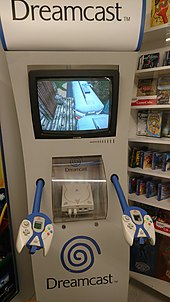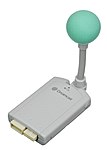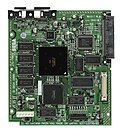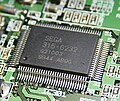History of video games/Platforms/Dreamcast
-
Dreamcast Console with Controller and VMU.
History
[edit | edit source]
Development
[edit | edit source]The Dreamcast was preceded by the Sega Saturn.
Developers were intrigued by the capabilities of the Dreamcast, with a less limiting environment enabling them to pursue more ideas easily.[1]
Sega wanted to reinvent their brand and considered 5,000 names before deciding on melding "Dream" and "Broadcast" to make the name Dreamcast, emphasizing the system's online capabilities as a major selling point in the net centric late 1990's.[2][3]
Launch
[edit | edit source]The Dreamcast was launched in Japan in November of 1998.[4] Notably for the VMU this launch was very close to the launch of the competing GameBoy Color.[5]
The Dreamcast was launched in the United States on September 9th, 1999 (9/9/99) for a cost of $199, and had over 300,000 preorders.[6] In the United States a million Dreamcast consoles were sold within the first month of launching.[7]
Legacy
[edit | edit source]
In early 2001 Sega announced they would discontinue Dreamcast production in favor of pursuing software on other platforms.[8]Sega Chairman and President Isao Okawa donated 85 billion yen (Then worth $692 million US Dollars) of personal funds to ensure Sega continued to operate while the company began to focus on software.[9][10] 9.13 million Dreamcast consoles were sold around the globe.[11][12]
Following it's discontinuation, the Dreamcast and its game library retained a cult following.[13][14] As recently as 2019, third party manufacturers found it viable to design and produce new peripherals for the system,[15] demonstrating that while the console failed to find mass market success, it still retained a notable longevity in its postmarket niche.
The legacy of the Dreamcast was bittersweet for Sega, its last major console was an innovative platform that was well received critically, but was unable to achieve the commercial success needed for Sega to remain in the console business.
The Dreamcast is uniquely situated in gaming chronology, as no major home console released around it. Thus while most credit it as being an early sixth generation system, some instead classify it as a late fifth generation system. Technologically, it far surpasses most fifth generation systems, yet falls far short of sixth generation systems.
Technology
[edit | edit source]Dreamcast was one of the nicest early consoles to develop for.—John Carmack, Tweet on December 11th, 2018.[16]
Compute
[edit | edit source]
A Hitachi SH-4 CPU clocked at 200 megahertz powers the Dreamcast.[17] The CPU is capable of about 1.4 GigaFLOPS.[18][19] Compared to the prior Sega Saturn, this CPU choice was a straightforward choice with good performance.
The Dreamcast uses a custom GPU called Holly, featuring a NEC PowerVR2 DC core clocked at 100 megahertz.[17][20] The GPU is capable of rendering about 7 million polygons with textures and lighting a second,[18] an impressive level or performance for the time.
The Dreamcast shipped with 16 megabytes of RAM.[21][17] The Dreamcast also has 8 megabytes of VRAM and 2 megabytes of Sound RAM.[17]
A Yamaha AICA Chip including a 32-bit ARM7DI CPU clocked at 45 megahertz and capable of 40 MIPS (million instructions per second) is dedicated for sound processing including surround sound support.[17][20] This was quite powerful for an audio chip, as this processor alone had a performance comparable the primary CPU of the previous generation PlayStation 1.[22]
Hardware
[edit | edit source]The Dreamcast uses special one gigabyte capacity GD-Rom disks.[17]
The Dreamcast supported Dial-Up internet, with a 33.6k speed modem at launch and a faster 56k speed modem after September 1999.[17] As a result of having standard online functionality, the Dreamcast became an early console to support downloadable content for games.[23]
The hardware is noted for the unique sounds it makes while in operation.[24]
The Dreamcast controller does not use traditional potentiometers for it's controller, but instead uses a hall effect sensor to determine analog positions by referencing internal magnets on the stick and triggers in relation to known sensor positions,[25][26] greatly reducing controller wear by eliminating a significant mechanical action.
Software
[edit | edit source]Most Dreamcast games used custom software from Sega.[17] The Windows CE SDK (Software Development Kit) was optionally available for developers to use on the Dreamcast, allowing the use of common Windows game development tools including the Visual C++ programming language, the DirectPlay network library, and the DirectX graphics API (Application Programming Interface) in game development for the Dreamcast.[27] Only about 50 Dreamcast games leveraged the. Windows CE SDK.[28]
Bleamcast was an early commercial emulator released for the Dreamcast, allowing the system to emulate certain PlayStation 1 games, a major accomplishment for the time which caught industry attention.[29]
Notable Games
[edit | edit source]
1998
[edit | edit source]1999
[edit | edit source]- Seaman
- Soulcalibur
- Shenmue - An early open world 3D RPG. The most expensive game produced at the time.
- ChuChu Rocket!
- Time Stalkers
Space Channel 5
[edit | edit source]Space Channel 5 is a game revolving around pressing specific buttons in tune to a beat, and features a comical story about a space reporter protagonist dance battling aliens.[30][31]
Read more about Space Channel 5 on Wikipedia.
2000
[edit | edit source]- The Typing of the Dead
- Skies of Arcadia
- Jet Set Radio / Jet Grind Radio
- Crazy Taxi
- Phantasy Star Online - Early online console RPG
- The Nomad Soul
- Samba de Amigo - Rhythm game featuring latin songs.
2001
[edit | edit source]Sonic Adventure II
[edit | edit source]Shenmue II
[edit | edit source]Shenmue II improved on the original by offering features that helped the player experience.[32] Shenmue II is set in a vast simulated Hong Kong.[33][34]
Rez
[edit | edit source]Rez is a shooter bound together with a rhythm game, where shots influence the music.[35] The game has psychedelic visuals which are influenced by gameplay.[36]
When this Dreamcast original was released for the PlayStation 2, a vibration accessory was released with it.[35]
Atelier Marie: The Alchemist of Salburg & Atelier Elie
[edit | edit source]A port from earlier platforms, this game had unusually open gameplay for the time, creating a more free form RPG experience.[37]
A bundled disk with bonus features like screensavers also accidentally included a virus for Windows computers, but left the Dreamcast unharmed.[38]
2002
[edit | edit source]Space Channel 5: Part 2
[edit | edit source]Space Channel 5: Part 2 is noted for it's number of endings.[39]
Late in development, Michael Jackson was added to the game as the character Space Michael.[40]
Gallery
[edit | edit source]Console Hardware
[edit | edit source]Console Accessories
[edit | edit source]Special Edition Consoles
[edit | edit source]Fuji Divers 2000 Series CX-1
[edit | edit source]The Divers 2000 Series CX-1 integrated a Dreamcast into a television.
Technology
[edit | edit source]Development
[edit | edit source]Marketing
[edit | edit source]-
Dreamcast logo North American version.
-
Dreamcast Japanese version logotype.
-
Dreamcast PAL version logotype.
External Resources
[edit | edit source]References
[edit | edit source]| Parts of this page are based on materials from: Wikipedia: the free encyclopedia. |
- ↑ McAloon, Alissa. "Dreamcast devs reflect on how the industry has changed since the console's debut". Retrieved 14 November 2020.
- ↑ "Hardware Classics: Sega Dreamcast". Nintendo Life. 16 April 2015. https://www.nintendolife.com/news/2015/04/hardware_classics_sega_dreamcast.
- ↑ "Sega Dreamcast at 20: the futuristic games console that came too soon" (in en). the Guardian. 28 November 2018. https://www.theguardian.com/games/2018/nov/28/sega-dreamcast-at-20-futuristic-console.
- ↑ "HISTORY SEGA 60th Anniversary". SEGA 60th Anniversary site. Retrieved 18 November 2020.
- ↑ "Community Blog by sonic429 // Things I am Tired of Explaining to Other Gamers". web.archive.org. 2018-03-13. https://web.archive.org/web/20180313200131/https://www.destructoid.com/blogs/sonic429/things-i-am-tired-of-explaining-to-other-gamers-484862.phtml.
- ↑ "The BG News September 9, 1999". BG News (Student Newspaper). 9 September 1999. Retrieved 1 November 2020.
- ↑ Sheffield, Brandon. "Dreamcast 20th anniversary interview extravaganza". Retrieved 14 November 2020.
- ↑ Watts, Jonathan (1 February 2001). "Sega to end production of Dreamcast console". The Guardian. Retrieved 14 November 2020.
- ↑ Tanikawa, Miki (17 March 2001). "Isao Okawa, 74, Chief of Sega And Pioneer Investor in Japan (Published 2001)". The New York Times. Retrieved 15 November 2020.
- ↑ McFerran, Damien (22 February 2012). "The Rise and Fall of Sega Enterprises". Eurogamer. Retrieved 15 November 2020.
- ↑ "Sega Dreamcast (1998-2001 )". History of Console Gaming. 18 October 2016. Retrieved 14 November 2020.
- ↑ "Sega Dreamcast is 20 years old today in the West". VGC. 9 September 2019. Retrieved 14 November 2020.
- ↑ "I'll Never Love a Console Like I Loved the SEGA Dreamcast". www.vice.com. Retrieved 14 November 2020.
- ↑ staff, Eurogamer (1 February 2009). "Dreamcast Cult Classics". Eurogamer. Retrieved 14 November 2020.
- ↑ "Finally, A Dreamcast Controller Built For Comfort" (in en-us). Kotaku. https://kotaku.com/finally-a-dreamcast-controller-built-for-comfort-1832759156#:~:text=The%20original%20Dreamcast%20controller%20is,classic%20design%20up%20to%20date..
- ↑ "https://twitter.com/id_aa_carmack/status/1072478057448030212". Twitter. Retrieved 1 November 2020.
{{cite web}}: External link in|title= - ↑ a b c d e f g h "Looking back at the Windows CE supporting Sega Dreamcast". Windows Central. 13 July 2017. Retrieved 4 November 2020.
- ↑ a b White, Matthew (26 July 2014). "Sega Dreamcast Hardware Analysis". The Solid State Gamer. Retrieved 4 November 2020.
- ↑ "THE WAR FOR America's thumbs -- (Rebuttal)". www.gamezero.com. Retrieved 21 November 2020.
- ↑ a b "Dreamcast Architecture A Practical Analysis". Rodrigo's Stuff. 7 October 2019. Retrieved 4 November 2020.
- ↑ "Double The RAM Of A Dreamcast Console For A Cool 32 MB". Hackaday. 26 June 2020. https://hackaday.com/2020/06/26/double-the-ram-of-a-dreamcast-console-for-a-cool-32-mb/. Retrieved 28 October 2020.
- ↑ "Everything You Have Always Wanted to Know about the Playstation But Were Afraid to Ask". Retrieved 22 February 2021.
- ↑ "The Sega Dreamcast Game That Just Got Its DLC Unlocked After 16 Years". CINEMABLEND. 19 March 2017. https://www.cinemablend.com/games/1637489/the-sega-dreamcast-game-that-just-got-its-dlc-unlocked-after-16-years.
- ↑ "Crunchy Dreamcast Loading Noises Make For A Charmingly Retro Twitch Stream" (in en-us). Kotaku. https://kotaku.com/crunchy-dreamcast-loading-noises-make-for-a-charmingly-1846434969.
- ↑ "Inside the Dualshock 3 controller | Web Portal for Benjamin J Heckendorn". https://www.benheck.com/inside-the-dualshock-3-controller/.
- ↑ "Dreamcast Controller". Sega Retro. 18 February 2021. Retrieved 22 February 2021.
- ↑ "Microsoft Announces Windows CE Toolkit for Dreamcast". Stories. 16 March 1999. Retrieved 4 November 2020.
- ↑ "Windows CE is Best OS and Dreamcast is Best PC?". Retrieved 4 November 2020.
- ↑ Hosie, Ewen (11 December 2017). "The history of bleem!" (in en). Eurogamer. https://www.eurogamer.net/articles/2017-12-11-the-history-of-bleem.
- ↑ "Cult Classic Space Channel 5 Is Getting The VR Treatment". CINEMABLEND. 10 September 2018. Retrieved 4 December 2020.
- ↑ Bramwell, Tom (12 June 2008). "No plans for Space Channel 5 remake". Eurogamer. Retrieved 4 December 2020.
- ↑ Herold, Charles (12 December 2002). "GAME THEORY; More Pace Plus Less Tedium Equals a Better Sequel (Published 2002)". The New York Times. Retrieved 5 December 2020.
- ↑ "Shenmue I & II (for PC) Review". PCMAG. Retrieved 5 December 2020.
- ↑ Kelly, Andy (20 August 2018). "Shenmue I & II review". PC Gamer. Retrieved 5 December 2020.
- ↑ a b Byford, Sam (25 September 2016). "Tokyo Thrift: The Rez Trance Vibrator is gaming's most intense peripheral". The Verge. Retrieved 5 December 2020.
- ↑ Shamoon, Evan (29 September 2016). "How 'Rez Infinite,' 'Thumper' Fuse Electronic Music With Virtual Reality". Rolling Stone. Retrieved 5 December 2020.
- ↑ Baker, Michael. "Atelier Marie: The Alchemist of Salburg Import Review". RPGamer. Retrieved 5 December 2020.
- ↑ Charnock, Tom. "Atelier: The Dreamcast Game That Could Destroy Your PC On Christmas Day". Retrieved 4 November 2020.
- ↑ Frank, Allegra (18 August 2017). "The humiliating heartbreak of failing Space Channel 5 Part 2". Polygon. Retrieved 4 December 2020.
- ↑ "How Michael Jackson Willed His Way Into Sega's Space Channel 5". Siliconera. 28 February 2012. Retrieved 4 December 2020.













































